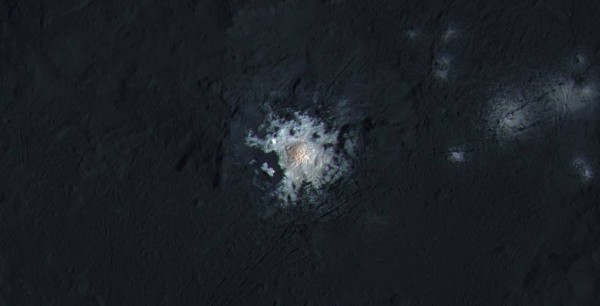By Ana Verayo, | March 11, 2017

The bright spots in the center of Occator Crater on Ceres are shown in enhanced color in this view from NASA's Dawn spacecraft. (NASA/JPL-Caltech/UCLA/MPS/DLR/IDA/PSI/LPI)
The dwarf planet Ceres possesses some mysterious "bright spots" inside its largest crater. New, stunning images of this crater revealed these highly reflective salts. Now, scientists say that this bright material was made due to ice volcanoes on Ceres.
This dome shaped crater is filled with salts known as Cerealia Facula, which are apparently triggered by cryovolcanic activity. According to Andreas Nathues from the Max Planck Institute for Solar System Research, based on its appearance and age, the bright material surrounding this dome was most likely formed by a recurring, eruptive process that also ejected material out of the central pit.
Like Us on Facebook
These bright spots captured by the NASA's Dawn spacecraft are made of salty deposits that are estimated to be 30 million years younger than the rest of the material inside the crater. Scientists suggest that the Occator Crater was created by a massive asteroid impact some 34 million years ago, which makes it four million years older.
However, this impact caused the crater to rise and spew sub-surface, shiny brine to around the crater. Nathues said that this massive impact inside the large Occator Crater could have triggered cryovolcanic activity on the dwarf planet. The team suggests that this ancient impact disturbed material underneath the surface of Ceres and the brine was transferred above the surface.
This also forced gasses to escape and later create a vent system. This vent system is now generating eruptions, and salt deposits have now formed in the central dome of the crater, resulting in these bright spots.
This new study suggests that the bright spots on Ceres were caused by spewing of ice volcanoes that ejected brine and salt over time. The final layer on the crater dome is now covered in bright, salt deposits. Scientists also say that similar crater domes have been spotted in moons Callisto and Ganymede of Jupiter.
However, scientists cannot confirm if the ice volcanoes inside the Occator crater are just dormant or have completely any activity. Researchers suggest that cryovolcanism inside this crater is just occurring at a low level due to a current haze covering the region. This new study was published in The Astronomical Journal.
-
Use of Coronavirus Pandemic Drones Raises Privacy Concerns: Drones Spread Fear, Local Officials Say

-
Coronavirus Hampers The Delivery Of Lockheed Martin F-35 Stealth Fighters For 2020

-
Instagram Speeds Up Plans to Add Account Memorialization Feature Due to COVID-19 Deaths

-
NASA: Perseverance Plans to Bring 'Mars Rock' to Earth in 2031

-
600 Dead And 3,000 In The Hospital as Iranians Believed Drinking High-Concentrations of Alcohol Can Cure The Coronavirus

-
600 Dead And 3,000 In The Hospital as Iranians Believed Drinking High-Concentrations of Alcohol Can Cure The Coronavirus

-
COVID-19: Doctors, Nurses Use Virtual Reality to Learn New Skills in Treating Coronavirus Patients







